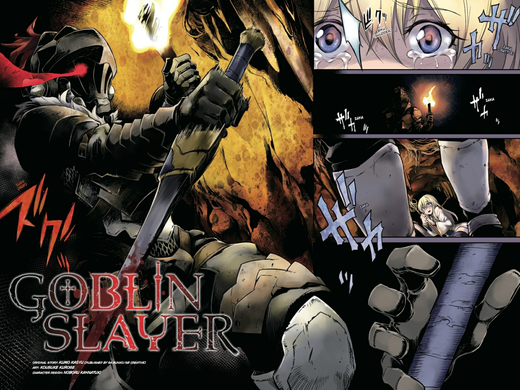
However, Goblin Slayer quietly shows the consequences of this violent world and the focus on men needing to protect women from rape and violence. I have to note that there are plenty of female adventurers who seek to protect people too. Likewise, many townsmen need protection–they face the fate of being hacked apart and eaten alive by goblins. Throughout Goblin Slayer. the heroes show a deep neuroticism caused by their profession. Goblin Slayer seeks to transfer the mentality of adventure games, the push for rewards and the enjoyment of violence, into a real world. But you also see the adventurers trying to get blind drunk after their latest murder spree as they wait for another quest at the guild hall. You see a female spell caster stoned 24-7. Even friendships among adventurers center around their shared experiences of death and the drinking lull between.
Every character exists as a role. They do not have names, and this further dehumanizes them. Their identities are rooted in violence and death. A name would suggest they have lives outside of being adventurers (and in the case of the supporting townspeople: victims). The Goblin Slayer himself gives us our best example.
The Goblin Slayer appears to be the strong, silent hero. The one who sees danger everyone else ignores. The one who defends helpless women. The one who wins against enormous odds. But he is a madman. The Goblin Slayer knows everything there is to know about goblins, obsessing about them every moment. He cannot communicate with people. The series makes much of his silence, but this social isolation stems from his obsession. He wants to commit genocide on goblins–by himself. Killing as he does leaves him scarred. We rarely see the man under all the armor, and when we do, we see a body armored in scars and experiences of violence. As his childhood friend relates in a scene, when he cannot kill goblins any longer, he will have nothing. She attempts to be his last human lifeline. She tries to be the last thread he can follow to escape the madness, and the Goblin Slayer feels at home with her. No matter how far he goes, he always returns to her family’s farm. Without the warm home she provides for him, he would lose himself in killing.
The Goblin Slayer shows signs of extreme PTSD with his withdrawal from most people and with his inferiority complex. However, the story does show he wants something more than just murder. He slowly joins other adventurers to help them achieve their quests (as long as he can kill goblins) and allows a priestess to join him. Although he retains his distance, he does desire connection with others. He carries a guilt complex from his inability to save his sister from rape and murder, and the complex keeps him from fully joining with others. He doesn’t want to be responsible for their well-being despite his desire to protect women from his sister’s fate. He doesn’t want to fail anyone again, yet he still craves human interaction. This tension appears often in his interactions with the priestess. The only person he wants to be responsible for is his childhood friend and his humanity she safeguards.
The violence the Goblin Slayer does to himself and the violence toward other men has been largely ignored. As much as I liked UEM’s article, Jekojeko misses this aspect of the show too.While it is true the anime focuses on hypermasculinity–the strong, silence knight saves the damsel, it quietly studies the price hypermasculinity extracts from the knight. Hypermasculinity is as poisonous for the man as it is for the woman. It labels male emotions such as sorrow, remorse, love, and tenderness as weak. It lauds violence, calculation, strength, violence, and protectiveness. Goblin Slayer, as a masculine character, cannot share his fears. He can’t share how much the violence hurts him. In one scene he does finally open about his feelings of fear and inadequacy, but he quickly shuts down again. Such moments are considered weaknesses by the code of hypermasculinity. Even the supporting cast of men shows the damage this code causes. The dwarf drinks and lives without thinking of the future. The other male adventurers do the same. They don’t have families other than their parties.
As I watched Goblin Slayer, I saw how the show supported male and female stereotypes and subvert them at the same time. Some viewers will see the story has supportive of such gender views: strong men, weak women. However, the story quietly shows the consequences of those mistaken views. It appears to be a man’s world, but those men are likely to die brutally. They are likely to die emotionally and spiritually broken. While women are raped by creatures, the men are spiritually raped by their own codes of conduct and the madness of their violent world. The Goblin Slayer has brutalized himself with his hypermasculinity and goal of committing genocide on the goblins.
Goblin Slayer focuses too much on a one-sided view of women and focuses too much on femininity purity. More diversity would be welcome. However, the focus serves as a way to show the consequences of so-called male competence. In such a world view, men have little to look forward to. They will either become too old and worn to do the one job they know. They will become sociopaths, or they will be hacked apart. All the while, they will increasingly fall out of touch with their humanity.

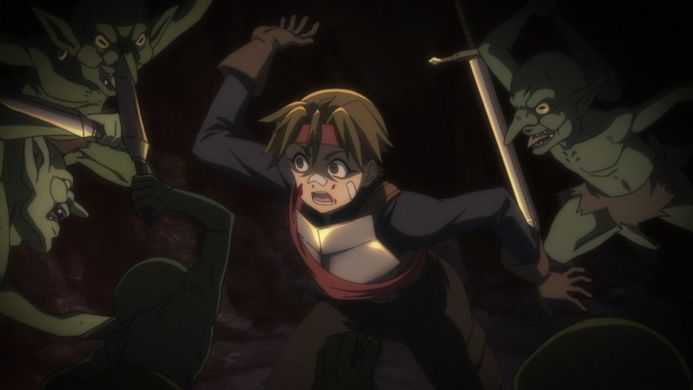
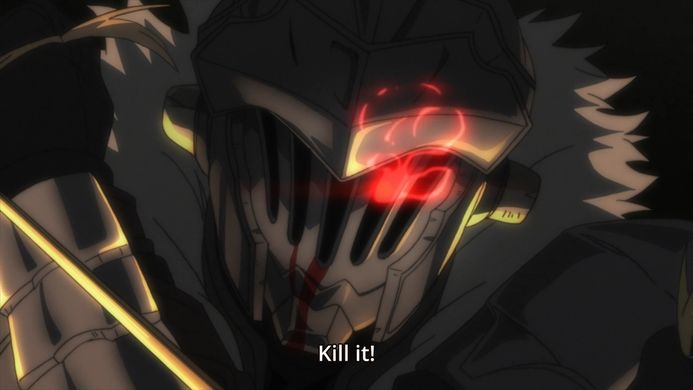
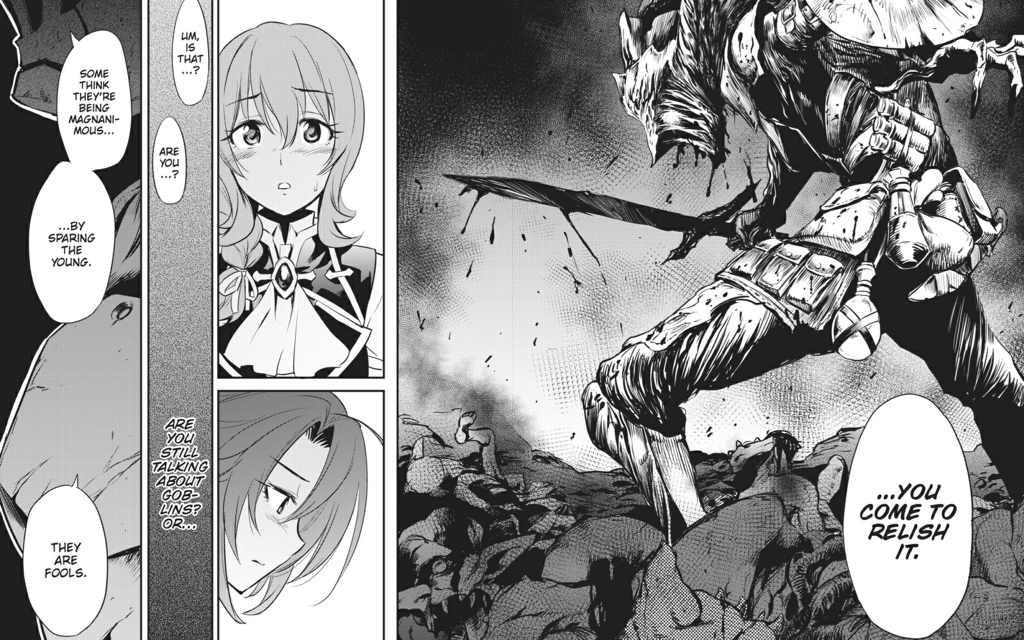
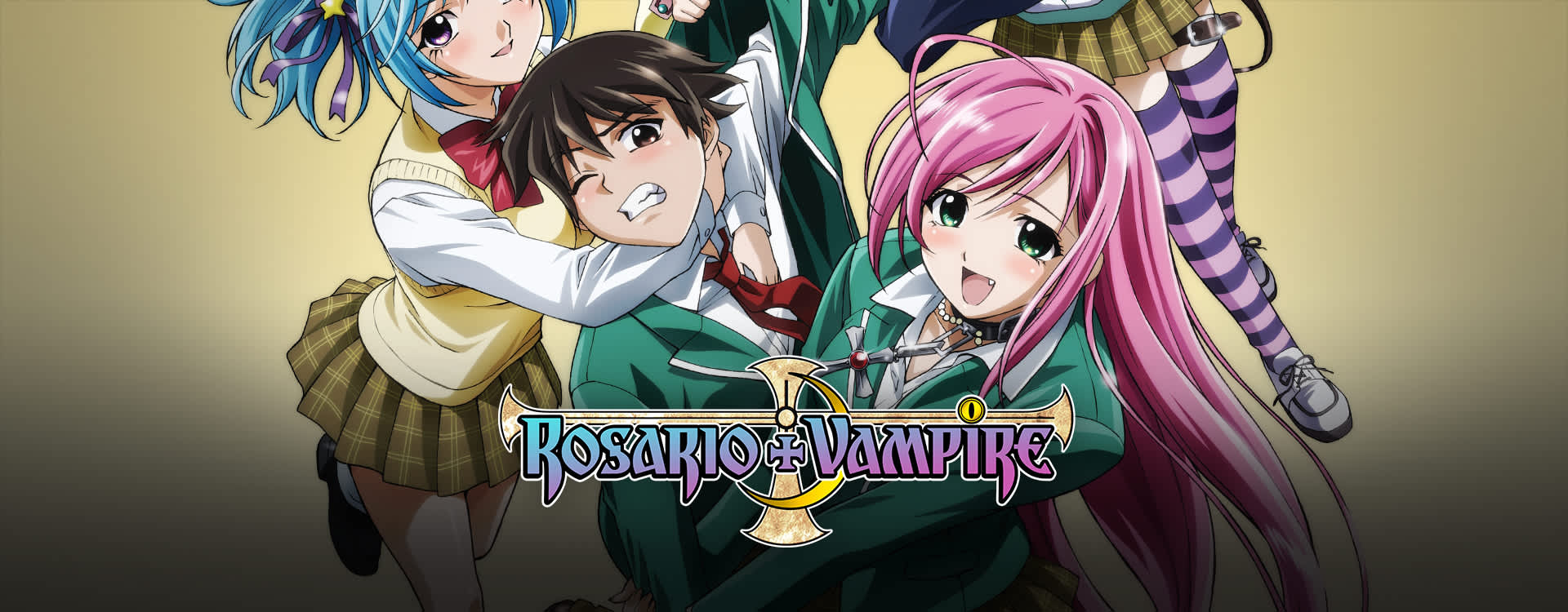
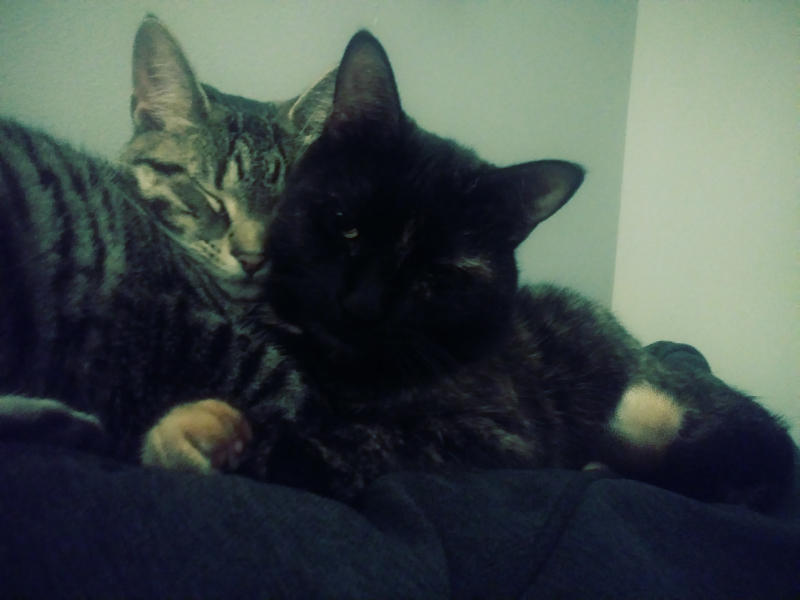
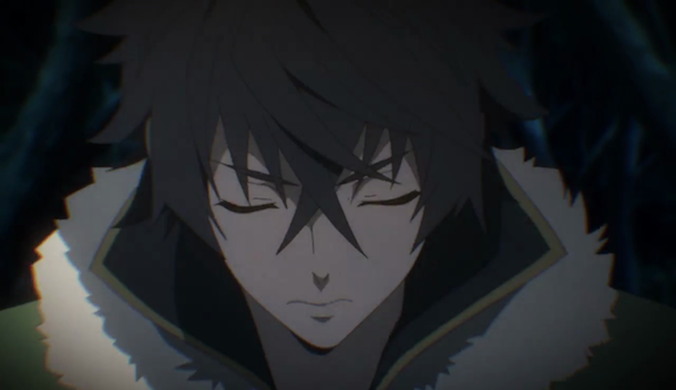
There’s definitely something unusual going on with the way masculinity is handled in this anime, I agree.
I can’t help notice that we seem to still be in a period of history where we are generally comfortable exploring the idea if a woman being raped, but not a man.
There’s a lot of folk saying this is because the anime is trying to represent an actual significant threat to society, even a more historical one.
I’m not sure though. The rape scenes do look sexualised to me, and I’m not convinced that’s an indicator of some latent personal deviancy.
I didn’t choose to write the damn thing, after all!
Many legal definitions of rape reduce or exclude men from being raped, especially by a woman.
Goblin Slayer’s first episode’s rape scenes looked sexualized to me as well. This diminishes the horror of the scene, which may or may not be intended. As I watched the series, that scene fell more into a sensual attention grab, which did serve some world-building importance–if poorly handled, aimed at netting viewers.
If you have a “latent personal deviancy” for watching the show, I’m in the same category. I’m perhaps worse because I’ve considered revisiting it for a deeper dive into its narrative! 😀
Insightful, but if the story’s final word is on the nobility of Goblin Slayer’s self-destructive hypermasculinity and racist hatred (in a Trump-manifesto world where racism is contrived to be virtuous), not that an alternative can and must be found to both these qualities and his idiotic idea of wiping out a whole species one dungeon-raid and sword-swing at a time…then it really is no better than a story that glorifies a male hero at the expense of rape victims. Reforming the guild and government to defend villages properly, send out an experienced professional hero with every level 1 party, and develop such things as a sleep gas spell to clear goblin caves, or a magical plague to kill so many of them, they can no longer capture women to reproduce themselves, I think aren’t only not really explored because blood, cheap hatemongering and gratuitous rape are the drawers here, not sensible solutions to problems. There’s also a toxic right wing hatred of government, institutions ‘bleeding-hearts’ and minorities, hand in hand with glorification of the all-competent male individual.
You make a good point about the anime failing to provide societal levels of solution. However, that lack of solution returns to the destructive nature of hypermasculinity as enshrined by society. I hesitate to pulled right and left wing ideas into this story. It is more a commentary on the state of fantasy within video games and masculinity in general than of Western and American politics.
This kind of incompetently crafted comprehension is exactly why HE will win.
and I shall be cherishing every moment of it!
How did that work out for you?
A lot of outright false misnomers and misreadings of the story here:
“You see a female spell caster stoned 24-7.”
If this is the character I think you are referring to, this is 100% false and wrong.
It is my impression of the character based on her faltering speech and movements in the anime. Her behavior resembles the behavior patterns I’ve seen from people who are high. How is my impression incorrect? Her role as a guide is interesting, however.
Hey, thanks for linking my article! Glad you enjoyed it.
I think we have similar outlooks overall. Part of my issue with Goblin Slayer is that it presents this damaging form of hypermasculinity, where certain emotions are coded as weak (which is something I believe I touched upon in my article), as something ultimately noble.
The Slayer’s path is a heroic tale of suffering and self-destruction. I think the show does a great job at exposing the problems of this, but I don’t think it ultimately wants its readers/viewers to take away the idea of diverting from it. Problematic hypermasculinity is explicated, but still accepted. I couldn’t find room to root for anything else as I watched. The ‘consequences’ of following this kind of masculinity are presented as a lesser of two evils when placed against the plight that the goblins, representing a corruption of the domestic ideal, bring to the world. The way men defend women is shown to be problematic, but I don’t think we’re given another option. The show paints that as it’s tragedy, but I don’t think that reflects how we can actually break away from hegemonic paradigms in the real world.
We are on the same page. I wanted to focus on the damage of the male side of things. The show does suggest the sacrifice of hypermasculinity is noble. The acceptance of hypermasculinity reflects the trap men are currently within. There really isn’t a viable, widely-accepted alternative version of masculinity. The show seems to point to this issue. The absence of an alternative rather fits the tragic message of the anime, but I suspect many male watchers won’t see that absence as the message.